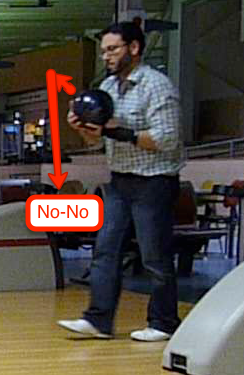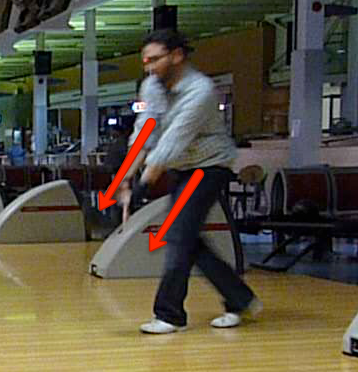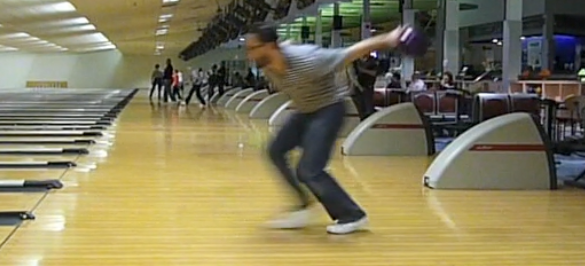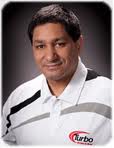So here we are again. I’ve taken my time to write about this as I am still hesitant. “Cautiously optimistic” would be the appropriate description of my feelings.
How did we get here?
Part 1. I started the story that originally started in 2009 (with pictures!!!).
Part 2. I further discussed the issue with many physicians and physical therapists. This article was the exchange I had with Paul Butcher, PT.
Part 3. Part 3 was the most recent recurrence of the injury.
So where does the bicep injury stand?
OK, I went to see Lou Marquez at Turbo Tech in Chesterfield, Michigan. Lou is a USBC gold certified coach with a long resume. You can research it yourself, but I can give you my impressions. First and foremost, Lou is a great guy. He is honest, genuine, and easy to talk to. Lou clearly enjoys what he does. I was in awe when I first walked into the Turbo training facility. They’ve got a pair of lanes, both synthetics, older and newer. It’s all set up with the necessary cameras for detailed coaching: from behind, in front, on the side, and from the top. They’ve also got strength training equipment available. Lou was one of the first in the bowling industry to recognize the need for bowling specific strength training. We forget that bowling is a sport. When someone envisions a bowler, they shouldn’t envision a heavy-set guy with a beer in one hand and a bowling glove in the other. The top guys are pretty fit and this should be the model. Anyway, I digress…
Lou has a brilliant bowling mind with two and a half decades of experience. He sees things in your game that are very difficult for most of us to pick up. Top coaches can do that.
What’s the deal with bicep Injuries in bowling?
I would guess that 90 out of 100 bowlers may never have the issues I have doing the exact same thing. However, I have issues. Thanks to those who have written to me and responded to my articles, it’s clear I am not alone. When I saw Amleto Monacelli holding his arm in pain on the show a couple of years ago, I couldn’t help but cringe knowing exactly the pain he was going through. I thought this was an issue of the “old” or “contemporary” style bowling where we were taught to bowl very differently than today. Then recently, we saw Osku Palerma with a torn bicep and it blew that theory out of the water.
So it is more common than anyone thought…
What did we cover with Lou Marquez?
Let me start by saying that my game is not awful. We are not reinventing my game at this stage. We are simply looking for key issues that could be contributing to my health issues. Lou started out by complimenting the positive things in my game. We underestimate this so much, especially with the low confidence right now, but I really appreciated how he made me feel comfortable about my game. Sometimes coaches try to completely retool players when all that may be needed are tweaks within the existing game. What must be taken into account is the level a bowler expects to reach. For me, I am at a stage where I simply want to continue to bowl and bowl well. I don’t expect to necessarily compete in lots of tournaments these days, but I would like to be anchor of my team again. Lou has the mindset, as I do as a coach, to work within what a bowler has. Let’s enhance people’s natural abilities.
Issue #1 – Proper swing motion

I heard the term “going up to go down” a lot. One issue I had was on my pushaway, I was actually lifting the ball slightly and then bringing it down. This up and down motion is a no-no as it is inefficient and could cause physical issues for me. The reason is that to lift the ball, even slightly, activates the bicep muscle. It is very difficult to get the bicep contracted, then relaxed then slightly contracted again. Once it’s firing in the motion, it’s firing. We simply wanted to get the ball into the swing with gravity.
Issue #2 – Timing
In addition, I got started early and you would think the the lifting would cause a delay. However, it was actually causing everything to happen quicker. With the arm in motion so soon, my feet had to catch up. This made me unconsciously take smaller steps to ensure I could get the 5 steps in on time to get to the slide. So my timing was too early, by a hair.
Now, I had done this intentionally as I always had late timing. To help you remember, late timing refers to the ball arrival meaning the sliding foot arrives well before the ball. Good timing is when the sliding foot arrives a split second before the ball. So late timing would be longer than a split second. Could be half a second or more, doesn’t matter. Early timing is the opposite. That’s when the ball arrives at the exact same time as the sliding foot or before. Many people can effectively bowl with late or early timing. However, the ideal timing allows for the most effective use of leverage and energy without more being added, like muscling.
With late timing as I had, my foot would arrive and then I have to pull the ball down in the swing. This pulling action is done by muscle since you can no longer wait for the effect of gravity. With early timing, the ball can go through its motions using mostly gravity, but you lose leverage since your legs aren’t planted.
I had intentionally created earlier timing in an attempt to eliminate the muscling. However, Lou explained that I went a fraction too far to early timing. Part of that had to do with the up and down motion.
So we worked in simply letting the ball come down into Step 2 (of a 5 step approach). The ball should be parallel with the leg as it gets to the ground, meaning it’s about 45 degrees from the ground. If you get it there, the rest should fall into place.

The result as evidenced by video was perfect timing. It took a bit to get used as any change in timing could be quite a shock to the muscle memory. However, it was worth the adjustment. It allowed for less muscling right from the start.
Issue #3 – Finishing
Well, this is also related to the timing issue. Given the earlier timing I had recently created, the shorter steps had me finishing almost 3 feet from the foul line. One thing I hadn’t realized up until that point was the impact finishing that far back form the foul line has on you. Unknowingly, when you arrive so far behind the foul line, you literally reach to get it over the line. That added an ever so slightly unnatural and unneeded muscle. As Lou helped me correct my swing timing, my feet were instantly changed. Just like that, I was finishing within a foot of the foul line. It’s amazing! The timing, cadence, and spacing of my feet were completely different simply by changing the timing of the start of the ball by what ultimately is less than a second.
Let’s stop here for now.
There were a couple of other things Lou and I discussed but they are not directly related to the injury so I will hold them back. Honestly, there is so much that if you try to work on too many things at once, you can’t get any one thing right. I had to take my time with this personally.
I want to once again thank Lou Marquez of Turbo Tech for his help. It was well worth the travel and time to spend the 3 hours with you. I would recommend it to any bowler serious about developing their game.
Stay tuned for another update…


